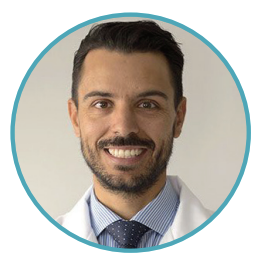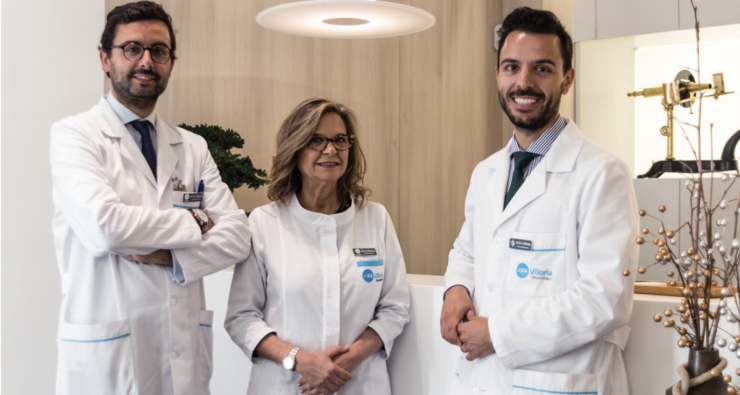Sponsored by STAAR Surgical Company

I am fortunate to work at an ophthalmology practice that I have special ties to. My mother, Carmen Villoria, MD, founded Vista Villoria Ophthalmologists in 1982 in the city of Pontevedra, Spain. At that time, my mother managed a small practice with only one employee. Under her guidance, the clinic has grown to now include multiple locations with an expanded scope of patient care. Somewhere along the way, my brother and I also fell in love with the ophthalmic specialty, and we now also practice with my mother. The three of us have worked together to further adopt a modern approach to patient care, to refocus our commitment to building trust and confidence with our patients, and to enhance our efforts to be known as a clinic of excellence. To us, this means embracing the latest technologies and procedures, including the EVO Visian ICL (STAAR Surgical).
HUMBLE BEGINNINGS
When my mother opened Pontevedra Ophthalmological Institute (now Vista Villoria Ophthalmologists), she did so with only the most essential technologies, staff, and office space. At that time, back in 1982, she performed cataract surgery with an extracapsular technique. She gradually introduced new equipment and procedures and hired additional team members as the practice evolved and she began treating more patients. In 2000, Clínica Villoria moved into a larger office building in Pontevedra, one with a dedicated OR, and more ophthalmologists were hired.
My mother’s vision to open a second clinic became a reality when my brother, Álvaro Velázquez Villoria, MD, and I joined the practice in 2018 (Figure 1). Many things have changed from the original solo practice model my mother built in 1982 to the multidisciplinary model my brother and I lead today, but we continue to rely heavily on my mother’s more than 30 years of experience. We have learned from her that incorporating the most advanced techniques and the latest technologies is crucial to success, and we do so now with a large team of ophthalmologists specializing in refractive surgery, presbyopia correction, cataract surgery, eyelids, retina, glaucoma, and pediatric ophthalmology.

Figure 1. Dr. Villoria (right) with his mother and brother, all surgeons at the same clinic.
GROWING PAINS
The process of passing the company torch to a new generation of management—in this case a mother to her two sons—is not without challenges. It involves risks, but it also provides an opportunity to implement new ideas. This generational shift in perspective manifested in the vision my brother and I share to enhance patient care in refractive surgery.
My mother started performing refractive surgery (LASIK, PRK, and ICL surgery) shortly before 2000. At that time, most patients opted for a corneal refractive surgery procedure because they assumed it was a safe, fast, and modestly invasive procedure. Today, however, patients better understand the benefits of refractive correction with an intraocular procedure. In fact, more patients than ever before are coming into our clinic requesting EVO ICL surgery. Because of the increasing number of word-of-mouth referrals we receive and the availability of more information online and on social media about the EVO Visian ICL, this procedure is now the one most requested by our patients. We also post patients testimonials on our social media channels, which helps to spark interest among other individuals who are interested in refractive surgery.
As a result of our efforts, the EVO Visian ICL is our primary procedure, and we offer bilateral sequential ICL implantation to most of our patients (Figure 2). This approach would have failed if we had not updated the mindset we had in 2000, which was that the EVO Visian ICL is an alternative when patients are not suitable for laser vision correction. From our perspective, those clinics that continue to operate this way are missing out on a large pool of potential patients.

Figure 2. Dr. Villoria sits with one of his ICL patients in the recovery area immediately after bilateral surgery.
We now take time to educate patients who are good candidates for ICL surgery about the risks and benefits of the procedure and that, in our opinion, the EVO ICL may be the safest and best option for them.1 We explain that it offers not only a high level of predictability and visual quality but also does not remove central corneal tissue, which may preserve future treatment options such as cataract surgery.1 We also inform patients that EVO ICL surgery has a lower incidence of dry eye symptoms postoperatively compared to corneal procedures,2 partly because it does not cause dry eye disease. STAAR Surgical is a great partner in patient education. The company provides direct-to-consumer campaigns, online tools, and educational resources that we share with patients.
We have made great strides to embrace this mindset as part of our new model of patient care. This new paradigm is also reflected in our surgical volume. In 2000, the Visian ICL only accounted for 10% of our refractive cases; today, it accounts for more than 75%.
LEADING BY EXAMPLE
It is important that patients have confidence in the practice they are choosing, in the surgical procedure they are considering, and in the surgeon who will be treating them. To build confidence in our practice, we use clear, concise, and consistent messaging across all channels of communication, including our phone messages, website, and social media messaging. To build confidence in the methods of surgical treatments we offer, we take time to educate patients and get to know their needs and desires. And lastly, to build their confidence in our surgeons, we communicate with them directly and honestly. In my case, I can share with patients that I have had refractive surgery.
In 2014, my mother performed SMILE on my eyes to correct -4.00 D of myopia. At that time, I thought it was the best option for me. Even though the result was very good and I am delighted with my vision, if I had the chance to do it again today, given our modern outlook on patient care, I would choose the EVO Visian ICL. The reason is multifaceted, but I share parts of it with my patients today. I tell them that the ICL is safe, predictable, efficacious,1 removable, and that it provides them with an excellent opportunity for future presbyopia-correcting or cataract surgery.
CONCLUSION
Generational change in a company’s succession is challenging yet rewarding and fruitful. I think the same is true for all leading medical practices that seek to grow and keep pace with new proven medical technologies. A thoughtful process that builds upon the practice’s foundation is key to a successful transfer of leadership. Vista Villoria Ophthalmologists is a perfect example of success, from its humble beginnings as a solo practice built by my mother to the multidisciplinary model my brother and I lead today. Through the years, we have always maintained the same goal: to be recognized as a clinic of excellence with cutting-edge technology and a focus on building trust and confidence with our patients.
1. Packer M. The Implantable Collamer Lens with a central port: review of the literature. Clinical Ophthalmology. 2018:12;2427-2438.
2. Naves JS, Carracedo G, Cacho-Babillo I. Diadenosine nucleotid measurements as dry-eye score in patients after LASIK and ICL surgery. Paper presented at: the American Society of Cataract and Refractive Surgery (ASCRS); April 20-24, 2012; Chicago.
